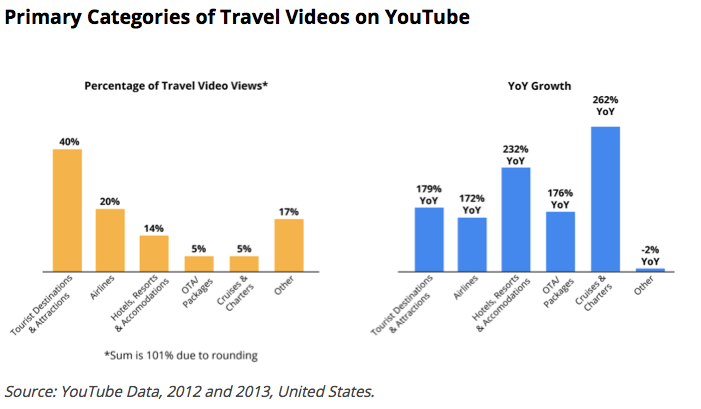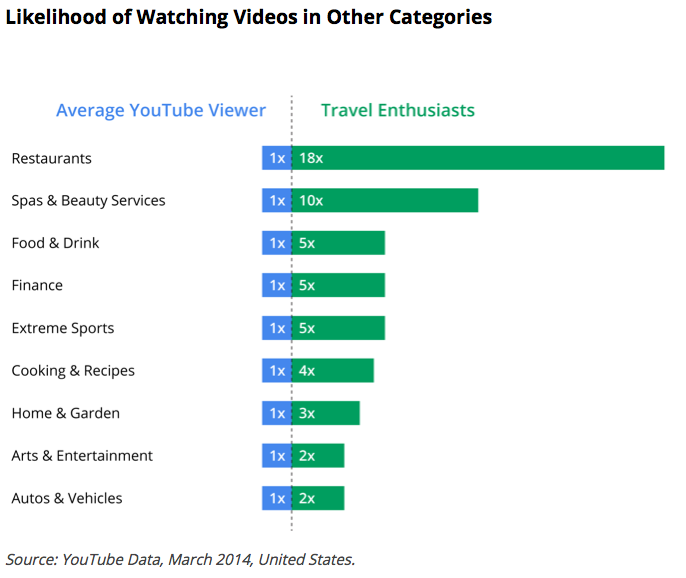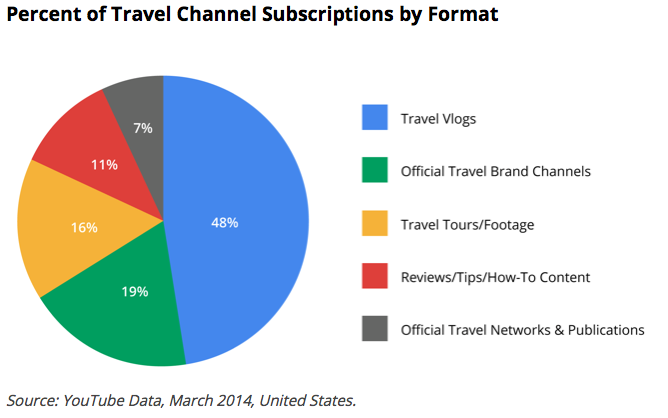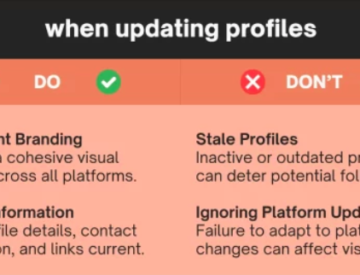This is the eleventh in a series of “Best Practices in Travel” posts to be published on this blog. Today, we focus on video marketing!
According to a study published by Think with Google in August 2014, travelers are spending more time watching online videos than ever before. Views of travel-related content are up 118% year over year (YoY) and according to the data, travelers are increasingly using mobile devices to consume travel-related videos anytime and anywhere.
In 2013, mobile devices accounted for roughly 30% of all travel video views, with mobile viewing up 97% on smartphones and 205% on tablets, year over year. (For more on this, please read Mobile Best Practices in Travel Marketing)

It makes sense to see tourist destinations and attractions on top of primary categories for travel videos on YouTube, knowing 87% of travelers start their travel search online, with an overwhelming majority (67%) undecided about their next destination.
Yet it’s interesting to see that most travel suppliers have jumped, or are jumping on the video bandwagon, in particular cruise & charters, hotels, resorts and accommodations showing the strongest growth comparing 2013 with 2012. It’s also not so surprising to see airlines coming in second position with one out of every five travel video views. Just think of KLM stunts, Westjet‘s Christmas Miracle or ads such as Messi vs Kobe for Turkish airlines.
Because travel is a lifestyle-oriented vertical, it’s no wonder travel enthusiasts seem to be more interested in topics such as restaurants, spas, food & drinks or sports, as these make up an important part of any travel experience. Travel marketing content creators take note: it’s not just about “travel” but rather the whole experience itself, including other categories such as the ones listed below:

Did you know that, according to a report published by emarketer earlier this year, digital video is expected to account for up to 30% of marketers’ total digital budgets by the end of 2014? With this in mind, here are five best practices for travel marketers wishing to embrace video or enhance their ongoing tactics.
5 BEST PRACTICES FOR THE TRAVEL INDUSTRY
1. Travel bloggers matter!
Travel watchers on YouTube are interested in community-generated content, but the majority of travel-related views (67%) are for brand or professionally released videos, in particular for brands such as Disney or Expedia.
Nevertheless, it’s interesting to note that travel vlogs – travel bloggers making use of video as main tactical channel – make up almost half of ALL travel channel subscriptions, ahead of travel brand channels and official travel networks and publications, i.e. Lonely Planet, National Geographic Traveler, etc.

From the chart above, it’s clear travelers want to connect with creators and brands. As of August 2014, subscriptions to top travel channels on YouTube have increased 106% year over year, and these subscribers watch 86% longer per view than non-subscribers do.
Talk about a loyal bunch! Official travel networks and publications may get more views, but travel vloggers get more subscriptions, which represents an opportunity to push out quality content with a more reliable, consistent reach.
2. It’s about storytelling
They say a picture is worth a thousand words, which explains why photos are so popular and shared across most social networks, in particular Facebook, Twitter, not to mention Pinterest and other photo-based media.
Videos, then, must be worth a million words, since they can be used to convey a much broader and deeper set of emotions, which make up the spine of any great storytelling initiative. Travel brands that make good use of video in their marketing toolkit are those who take advantage of this medium and its competitive set.
Here are two great examples of destinations that get it: South Africa and the Canary Islands. The folks at South African Tourism make good use of social media and digital outposts in general, so video is no exception in their strategy. Their most recent destination brand video is a pure gem of storytelling, seeing this couple enjoying South Africa in a different way than expected. Beauty in the eye of the beholder? Just watch this video until the end, it’s worth it!
And then you have the Canary Islands, which took a different approach, giving “carte blanche” to seven independent movie-makers from around the world to film their own travel video of one of the seven islands that make up the Canary archipelago. Launched earlier in 2014, it’s a daring approach, yet it truly gives way for storytelling with a different, unbiased perspective, which is what people strive to connect with. Check out the “making of” video below, or follow the series with the hashtag #7stories.
3. Add oomph to reviews
 Travel review sites have become a very important component in the decision-making process, so it’s no wonder to see photos, both professional and user-generated, playing a pivotal role as well. Such is the case on both TripAdvisor, Cruise Critic or Yelp, along with other user-generated sites where travelers can review restaurants, airlines, attractions, transportation, hotels and destinations.
Travel review sites have become a very important component in the decision-making process, so it’s no wonder to see photos, both professional and user-generated, playing a pivotal role as well. Such is the case on both TripAdvisor, Cruise Critic or Yelp, along with other user-generated sites where travelers can review restaurants, airlines, attractions, transportation, hotels and destinations.
But did you know Yelp now allows for its iPhone users to make 3-12 second video clips and integrate them with reviews? With 68 millions users going to Yelp via a mobile site or app, it’s only a matter of time until this feature becomes available on Google Play. Most likely TripAdvisor and other sites will follow, so will travel brands be ready to embrace this new reality?
4. Video is not only on Youtube
Because YouTube belongs to Google, it’s a logical move to have a dedicated channel and use it as part an overarching digital strategy for any brand. But truth is, not all travelers are the same, nor do they consume travel videos on the same channels, so it’s important to consider other options, such as Vimeo, Daily Motion and even short-video mobile applications such as Vine (clips up to 6 seconds) or Instagram (clips up to 15 seconds).
Below is a novel example of a Chicago-based travel tech company using Vine to promote a contest together with United’s loyalty program.
A recent BBC article covered the topic with up-and-coming Vine influencers paid to talk about, or make a video, using promoted content, such as Coca Cola beverages or music by Jennifer Lopez. How long until we see hotel companies, destinations or attractions do the same with targeted influencers?

AirBnB pulled a similar stunt earlier in 2014, launching its “Shorts” user-generated video contest, with Instagram as video application. Users had 15 seconds to highlight a destination, and the winner was sent to the 2014 edition of the Sundance film festival, celebrating indie movie-making and short films.
5. Integrate across other channels
Video is a lot easier to make than even just a couple of years ago, thanks in great part to accessible technology and applications, from desktop to mobile. Thus, we’re seeing brands integrating video as part of the customer service equation, for example integrating a video of things to see and do at a destination, along with the hotel confirmation email. Some will even provide real-time video-chat on their website to answer customer queries, helping conversion rates along the way.
Even TV ads can now be repurposed on your YouTube channel, integrated within newsletters and shares across social networks, giving it a second life and providing more reach and bang for the (production) costs!
BONUS: WEB SERIES
Earlier in 2014, Tourisme Montreal launched a six-part web series called Montreal Boy, some strings attached, just like you’d watch a television series on your home screen or Netflix. The novel aspect here is that the destination itself, Montreal, plays a second role to the main characters, which are a gay couple. This web series is a part of Montreal’s unique campaigns for the LGBT community, and it contributes to a brand positioning as gay-friendly travel destination.
Another example comes from New York Times, which recently launched a series of travel videos, published every wednesday, adding to its traditional travel section with 36-hours videos at out-of-the-ordinary destinations. Interesting to see a more traditional media making use of video to enhance its readership, while pushing quality content useful to the travel industry, wouldn’t you say?
If you have any other examples or best practices you’d like to share, please leave a comment in the section below. Thanks!









Leave a Reply